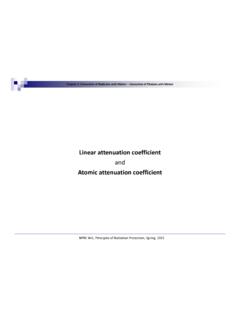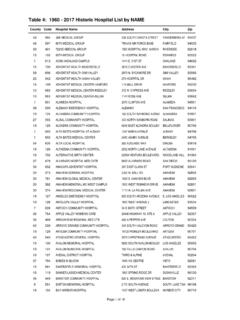Transcription of COM - Compton Scattering
1 COM - Compton Scattering Physics 111B: Advanced Experimentation Laboratory University of California, Berkeley Contents 1 Compton Scattering Description (COM) 1. 2 Compton Scattering Experiment Photos 2. 3 Before the 1st Day Lab and Standard Operating Procedure, SOP's for Compton 3. 4 Objectives 3. 5 Introduction 4. 6 Theory 4. 7 Apparatus 4. Source .. 5. CdTe Detector .. 6. Scattering Apparatus .. 7. Radiation Shield .. 7. 8 Standard Operating Procedure (SOP) for Seal Source experiment 8. 9 Questions 12. 10 References 13. 1 Compton Scattering Description (COM).
2 1. Note that there is NO eating or drinking in the 111-Lab anywhere, except in rooms 282. & 286 LeConte on the bench with the BLUE stripe around it. Thank you the Staff. When photons collide with electrons they give up some of their energy, and their wavelengths are thus increased. In addition, the photons are scattered out of their original direction of motion. This phenomenon is called the Compton Effect, and is described with an equation relating the energy loss of the photon to the Scattering angle. In this experiment, X-rays emitted from a radioactive Americium source are scattered by atomic electrons in an aluminum target.
3 You will measure the energy loss vs. the Scattering angle to cross check the classical equation and the Klein-Nishina distribution. The experiment offers a good introduction to X-ray detection and measurement, with emphasis on semi- conductor detectors. You will learn how to use a pulse height analyzer, and how to work safely around radioactive materials. For this experiment, after the initial calibrations of the apparatus, you can set up a run and leave the equipment operating during the lab period, collect your data at the end of the day, before setting up an overnight run.
4 You do not have to be in the lab all the time. Since you must keep your calibrations the same once you have set them, you should schedule this experiment on consecutive days, and you will need at least one over-the-weekend run. 1. 1. Pre-requisites: None 2. Days Allotted for the Experiment: 7. All pages in this lab. Note To print Full Lab Write-up click on each link below and print separately I. Compton Scattering (current page). This lab will be graded 20% on theory, 30% on technique, and 50% on analysis. For more information, see the Advanced Lab Syllabus. Comments: Submit feedback using this form.
5 2 Compton Scattering Experiment Photos Figure 1: Aluminum Reflector Rods Figure 2: X 1-2-3 X-Ray Detector and Source Click here to see larger picture Click here to see larger picture Figure 3: Lead-Shielded Box for Figure 4: Lead-Shielded Box Interior the Compton Apparatus. with Compton Apparatus. Click here to see larger picture Click here to see larger picture 2. 3 Before the 1st Day Lab and Standard Operating Procedure, SOP's for Compton Complete the COM Pre Lab found in the Signature Sheet for this lab. Print the signature sheet, discuss the experiment and pre-lab questions and answers with any faculty member or GSI, and receive their signature.
6 In the course of the lab there will be examination points where you must STOP and get a GSI or professor to verify your understanding and/or verify proper experimental setup. You cannot skip these checkpoints, and must receive signatures demonstrating that you've consulted the staff. Some experiments may have mid lab questions that must be completed by specific days of the experiment. The completed Signature Sheet MUST be submitted as the first page of your lab report. Quick links to the checkpoint questions are found here: 1 2 3 4 5. 1. Note: In order to view the private Youtube videos hosted by the university, you must be signed into your Google account.
7 View the two videos Compton Scattering and Light Sources and Detectors . 2. View the Radiation Safety Video. After watching the video in the 111-Lab, get a pink Radiation Safety form from a 111-Lab staff person. Fill it out & sign the form for getting a Radiation Ring. 3. Now complete the Radiation Safety Training Radiation Safety After completion of Training turn in all forms to Winthrop Williams . 4. View the Introduction to Error Analysis Video and Error Analysis Notes. 5. Read the Standard Operating Procedures (SOP) for this lab before starting. 6. Last day of the experiment please fill out the Experiment Evaluation Suggested Reading: Melissinos.
8 Compton Scattering pp. 252-265 and pp. 369-384; Experiments in Modern Physics, (Academic Press, 1966). # and or [pp. 369-384 in second ed.] # DP5 ..Quick Start Guide 1. X-123 ..X-123 Amplifier Detector Quick Start Guide 2. Knoll, Radiation Detection and Measurement, (Wiley, 1979). , , and for a good descrip- tion of general detection principles, and semi-conductor detectors; and the Compton Effect article attached to this lab manual. Radiation Interactions, General Radiation Detec- tion, Radiation Spectroscopy with Scintillators, Semiconductor Detectors, and SiLi Solid State Detectors 3.
9 Dp5 User Manual More References [Physics 111 Library Site]. You should keep a laboratory notebook. The notebook should contain a detailed record of everything that was done and how/why it was done, as well as all of the data and analysis, also with plenty of how/why entries. This will aid you when you write your report. 4 Objectives Learn about the Compton Effect Learn the Klein-Nishina formula 3. Learn about Scattering cross section for quantum Scattering Measure the mass of the electron Apply error analysis techniques to a data set that you collect 5 Introduction The Scattering of X-rays by electrons was explored by A.
10 H. Compton in the early part of the 20th century. The reduced frequency of the scattered photon is fundamental evidence for the proportionality of energy to the frequency of light, and for the relativistic kinematics of electrons. In 1929 Klein and Nishina calculated the angular distribution of Compton Scattering from free electrons in one of the first applications of quantum electrodynamics (QED). The Klein-Nishina gives the probability, the differential cross section, that a photon will be scattered into a given solid angle. Today, when applied to electromagnetic processes 50 million times more energetic, QED predictions still appear to be borne out.







